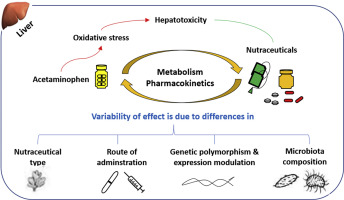当前位置:
X-MOL 学术
›
J. Food Drug Anal.
›
论文详情
Our official English website, www.x-mol.net, welcomes your feedback! (Note: you will need to create a separate account there.)
Association of antioxidant nutraceuticals and acetaminophen (paracetamol): Friend or foe?
Journal of Food and Drug Analysis ( IF 3.6 ) Pub Date : 2018-04-01 , DOI: 10.1016/j.jfda.2017.11.004 Mohamed Abdel-Daim 1 , Abdelrahman Ibrahim Abushouk 2 , Raffaella Reggi 3 , Nagendra Sastry Yarla 4 , Maura Palmery 3 , Ilaria Peluso 5
Journal of Food and Drug Analysis ( IF 3.6 ) Pub Date : 2018-04-01 , DOI: 10.1016/j.jfda.2017.11.004 Mohamed Abdel-Daim 1 , Abdelrahman Ibrahim Abushouk 2 , Raffaella Reggi 3 , Nagendra Sastry Yarla 4 , Maura Palmery 3 , Ilaria Peluso 5
Affiliation

|
Acetaminophen (paracetamol or APAP) is an analgesic and antipyretic drug that can induce oxidative stress-mediated hepatotoxicity at high doses. Several studies reported that antioxidant nutraceuticals, in particular phenolic phytochemicals from dietary food, spices, herbs and algae have hepatoprotective effects. Others, however, suggested that they may negatively impact the metabolism, efficacy and toxicity of APAP. The aim of this review is to discuss the pros and cons of the association of antioxidant nutraceuticals and APAP by reviewing the in vivo evidence, with particular reference to APAP pharmacokinetics and hepatotoxicity. Results from the murine models of APAP-induced hepatotoxicity showed amelioration of liver damage with nutraceuticals coadministration, as well as reductions in tissue markers of oxidative stress, and serum levels of hepatic enzymes, bilirubin, cholesterol, triglycerides and inflammatory cytokines. On the other hand, both increased and decreased APAP plasma levels have been reported, depending on the nutraceutical type and route of administration. For example, studies showed that repeated administration of flavonoids causes down-regulation of cytochrome P450 enzymes and up-regulation of uridine diphosphate glucuronosyltransferases (UGT). Moreover, nutraceuticals can alter the levels of APAP metabolites, such as mercapturate glucuronide, sulfate and cysteine conjugates. Overall, the reviewed in vivo studies indicate that interactions between APAP and nutraceuticals or plant foods exist. However, the majority of data come from animal models with doses of phytochemicals far from dietary ones. Human studies should investigate gene-diet interactions, as well as ethnic variability in order to clarify the pros and cons of co-administering antioxidant nutraceuticals and APAP.
中文翻译:

抗氧化营养品和对乙酰氨基酚(扑热息痛)的协会:朋友还是敌人?
对乙酰氨基酚(扑热息痛或 APAP)是一种镇痛和解热药物,可在高剂量下诱导氧化应激介导的肝毒性。几项研究报告说,抗氧化营养保健品,特别是来自膳食食品、香料、草药和藻类的酚类植物化学物质具有保肝作用。然而,其他人则认为它们可能会对 APAP 的代谢、功效和毒性产生负面影响。本综述的目的是通过回顾体内证据,特别是关于 APAP 药代动力学和肝毒性的证据,讨论抗氧化营养品和 APAP 之间关联的利弊。APAP 诱导的肝毒性小鼠模型的结果显示,联合使用营养保健品可改善肝损伤,并降低氧化应激的组织标志物,肝酶、胆红素、胆固醇、甘油三酯和炎性细胞因子的血清水平。另一方面,据报道,APAP 血浆水平升高和降低,这取决于营养品类型和给药途径。例如,研究表明,反复给予类黄酮会导致细胞色素 P450 酶的下调和尿苷二磷酸葡萄糖醛酸转移酶 (UGT) 的上调。此外,保健品可以改变 APAP 代谢物的水平,例如巯基葡糖苷酸、硫酸盐和半胱氨酸结合物。总体而言,经审查的体内研究表明,APAP 与营养食品或植物性食品之间存在相互作用。然而,大多数数据来自动物模型,其中植物化学物质的剂量与膳食中的剂量相差甚远。
更新日期:2018-04-01
中文翻译:

抗氧化营养品和对乙酰氨基酚(扑热息痛)的协会:朋友还是敌人?
对乙酰氨基酚(扑热息痛或 APAP)是一种镇痛和解热药物,可在高剂量下诱导氧化应激介导的肝毒性。几项研究报告说,抗氧化营养保健品,特别是来自膳食食品、香料、草药和藻类的酚类植物化学物质具有保肝作用。然而,其他人则认为它们可能会对 APAP 的代谢、功效和毒性产生负面影响。本综述的目的是通过回顾体内证据,特别是关于 APAP 药代动力学和肝毒性的证据,讨论抗氧化营养品和 APAP 之间关联的利弊。APAP 诱导的肝毒性小鼠模型的结果显示,联合使用营养保健品可改善肝损伤,并降低氧化应激的组织标志物,肝酶、胆红素、胆固醇、甘油三酯和炎性细胞因子的血清水平。另一方面,据报道,APAP 血浆水平升高和降低,这取决于营养品类型和给药途径。例如,研究表明,反复给予类黄酮会导致细胞色素 P450 酶的下调和尿苷二磷酸葡萄糖醛酸转移酶 (UGT) 的上调。此外,保健品可以改变 APAP 代谢物的水平,例如巯基葡糖苷酸、硫酸盐和半胱氨酸结合物。总体而言,经审查的体内研究表明,APAP 与营养食品或植物性食品之间存在相互作用。然而,大多数数据来自动物模型,其中植物化学物质的剂量与膳食中的剂量相差甚远。

























 京公网安备 11010802027423号
京公网安备 11010802027423号